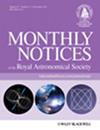NuSTAR and Swift observations of two supergiant fast X-ray transients: AX J1841.0-0536 and SAX J1818.6-1703
IF 4.8
3区 物理与天体物理
Q1 ASTRONOMY & ASTROPHYSICS
引用次数: 0
Abstract
Supergiant fast X-ray transients are wind-fed binaries hosting neutron star accretors, which display a peculiar variability in the X-ray domain. Different models have been proposed to explain this variability and the strength of the compact object magnetic field is generally considered a key parameter to discriminate among possible scenarios. We present here the analysis of two simultaneous observational campaigns carried out with Swift and NuSTAR targeting the supergiant fast X-ray transient sources AX J1841.0-0536 and SAX J1818.6-1703. A detailed spectral analysis is presented for both sources, with the main goal of hunting for cyclotron resonant scattering features that can provide a direct measurement of the neutron star magnetic field intensity. AX J1841.0-0536 was caught during the observational campaign at a relatively low flux. The source broad-band spectrum was featureless and could be well described by using a combination of a hot blackbody and a power-law component with no measurable cut-off energy. In the case of SAX J1818.6-1703, the broad-band spectrum presented a relatively complex curvature which could be described by an absorbed cut-off power-law (including both a cut-off and a folding energy) and featured a prominent edge at ∼7 keV, compatible with being associated to the presence of a ‘screen’ of neutral material partly obscuring the X-ray source. The fit to the broad-band spectrum also required the addition of a moderately broad (∼1.6 keV) feature centered at ∼14 keV. If interpreted as a cyclotron resonant scattering feature, our results would indicate for SAX J1818.6-1703 a relatively low magnetized neutron star (∼1.2 × 1012 G).NuSTAR 和 Swift 对两颗超巨型快速 X 射线瞬变体的观测:AX J1841.0-0536 和 SAX J1818.6-1703
超巨星快速 X 射线瞬变体是寄存有中子星吸积器的风力双星,在 X 射线领域显示出奇特的可变性。人们提出了不同的模型来解释这种变异性,而紧凑天体磁场强度通常被认为是区分各种可能情况的关键参数。我们在此介绍对 Swift 和 NuSTAR 针对超巨型快速 X 射线瞬变源 AX J1841.0-0536 和 SAX J1818.6-1703 同时进行的两次观测活动的分析。本文对这两个源进行了详细的光谱分析,主要目的是寻找回旋共振散射特征,从而直接测量中子星的磁场强度。AX J1841.0-0536 是在观测活动期间以相对较低的磁通量捕获到的。源宽带光谱没有特征,可以用热黑体和幂律分量(没有可测量的截止能量)的组合来很好地描述。在 SAX J1818.6-1703 的情况下,宽带光谱呈现出相对复杂的曲率,可以用吸收截止幂律(包括截止能量和折叠能量)来描述,并在∼7 keV 处有一个突出的边缘,这与部分遮挡 X 射线源的中性物质 "屏幕 "的存在有关。为了拟合宽波段光谱,还需要增加一个中等宽(∼1.6 keV)的特征,其中心为∼14 keV。如果将其解释为回旋共振散射特征,我们的结果将表明 SAX J1818.6-1703 是一颗磁化率相对较低的中子星(∼1.2 × 1012 G)。
本文章由计算机程序翻译,如有差异,请以英文原文为准。
求助全文
约1分钟内获得全文
求助全文
来源期刊

Monthly Notices of the Royal Astronomical Society
ASTRONOMY & ASTROPHYSICS-
CiteScore
9.10
自引率
37.50%
发文量
3198
审稿时长
3 months
期刊介绍:
Monthly Notices of the Royal Astronomical Society is one of the world''s leading primary research journals in astronomy and astrophysics, as well as one of the longest established. It publishes the results of original research in positional and dynamical astronomy, astrophysics, radio astronomy, cosmology, space research and the design of astronomical instruments.
 求助内容:
求助内容: 应助结果提醒方式:
应助结果提醒方式:


